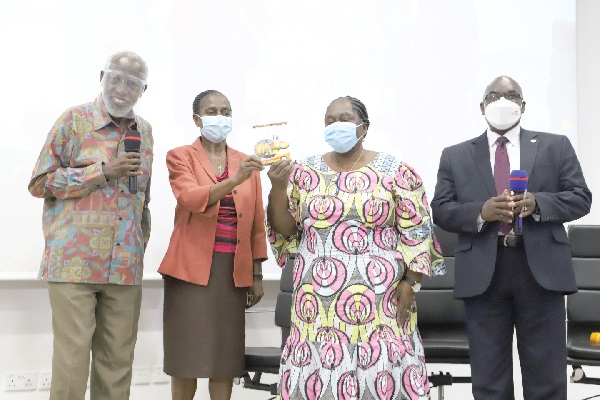
NDPC launches long-term Ghana@100 development plan
The National Development Planning Commission (NDPC) has launched a long-term national development plan and called on all political parties to link future manifestos to the plan for sustainable development.
The plan, dubbed: “Ghana@100”, spells out development priorities in key sectors and provides strategic interventions for the consolidation of the country's democracy in the effort to achieve key development milestones by 2057, when Ghana turns 100.
Advertisement
The document sets out Ghana's development agenda in four thematic areas — Governance, peace and security; the economy, with focus on building an industrialised and resilient structure; Social pillar, which highlights measures to bridge inequality and gender disparity gaps, while promoting quality human resource, and the Environment pillar, which focuses on preserving the country's natural resources.
The plan was launched by the Chairman of the NDPC, Professor Emeritus Stephen Adei, at a ceremony in Accra last Tuesday.
According to him, the document was a fusion of a number of development plans and national agendas.
Drivers of the plan
Prof. Adei explained that the document provided an agenda of 10 drivers of sustainable development that served as a prerequisite for the realisation of the Sustainable Development Goals (SDGs).
The drivers are ensuring peace and security, change in values and attitudes, quality political leadership, efficient public service, micro-economic stability, human capital development and high productivity.
The others are promoting science, technology and innovation, infrastructure development, affordable energy and land reforms.
The NDPC Chairman said unlike political party manifestos that fell short of providing funding sources for their policies, the long-term plan had provided sources of funding for all the policies.
Additionally, he said, value for money mechanisms had also been provided in the document.
Linkages
Speakers at the event described the launch of the plan as a major step towards sustainable national development since it would serve as a guide to political parties to develop their manifestoes based on national priorities.
The speakers were the Director of the Institute of Statistical, Social and Economic Research (ISSER) of the University of Ghana, Professor Peter Quartey; a lecturer at the Department of Political Science at the University of Ghana, Prof. Joseph Atsu Ayee, and the Chairperson of the Star-Ghana Foundation, Dr Esther Offei-Aboagye.
They agreed that if the plan was implemented well, it would bring an end to the situation where political parties developed their manifestos around the four-year electoral cycle.
Prof. Quartey said although political party manifestos contributed immensely to the national development agenda and the strengthening of democracy, it was important to link the promises to the larger development plan.
“Linking manifestos to the National Development Plan, as well as the continental development agenda, will reduce the number of unfulfilled promises by political parties when they win power,” he said.
Accountability
Prof. Ayee said although Ghana had made considerable gains in tackling development challenges since the beginning of the Fourth Republic in 1992, more could have been achieved if there was a long-term plan for sustainable development.
He observed that in the absence of that, the country’s development trajectory had not been consistent because political parties that won elections and formed governments implemented policies that were not sustainable.
He said having launched the development blueprint, there was the need for the citizenry and groups to demand accountability by tracking government’s performance.
For her part, Dr Offei-Aboagye said the citizenry needed to get involved in the governance process and ensure that political parties aligned their manifestos to the development plan.
“It appears that the cart has been put before the horse, where political party manifestos inform the country’s direction every four years. We should now have a situation where political parties will tell us how they will use their manifestos to achieve the long-term plan,” she said.
Ghana’s development plans
Ghana has been pursuing many development initiatives since the colonial era, all targeted at improving on the country’s development process.
Among them was the 1919 Development Plan of the colonial era, spanning the period 1920 to 1930.
That development plan gave birth to key projects such as the Korle Bu Teaching Hospital, the Takoradi Harbour and the railway system.
Former President Kwame Nkrumah’s seven-year development plan (October 1, 1963, to September 30, 1970) led to achievements including the Akosombo Dam, the Tema Harbour, various educational institutions, including the Kwame Nkrumah University of Science and Technology (KNUST), and import-substitution industries.
Some of the development plans of the past few decades are the Rural Development Plan (1971-72), the Third Five-Year Plan (1975/76-1979/80), the Economic Recovery Programme (ERP) Phase 1-3 (1983-1991).
In the Fourth Republic, national development policies such as Political and Economic Adjustments (1992-1996), Ghana’s Vision 2020 (1996-2020), and medium-term strategies, such as the Ghana Poverty Reduction Strategy (GPRS II) (2006-2009), the Ghana Shared Growth and Development Agenda I (GSGDI) (2010-2013) and the Ghana Shared Growth and Development Agenda II (GSGDII) (2014-2017), have also been rolled out, in line with the 1992 Constitution.



